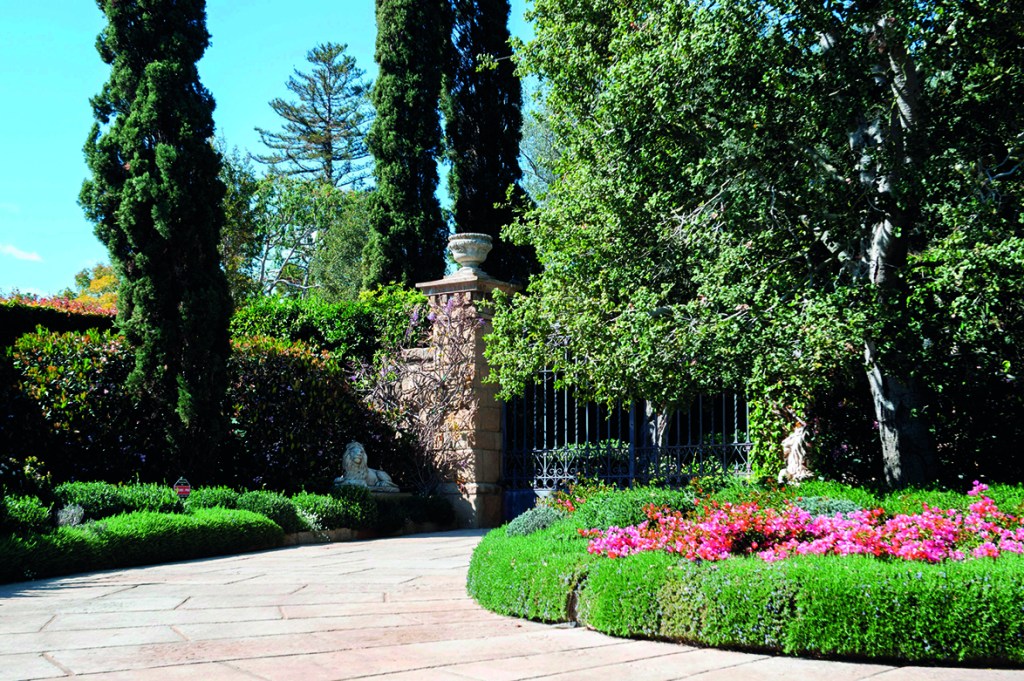‘The Montecito real estate market has gone bonkers,’ says realtor Brian King of this leafy enclave which is often referred to as California’s last paradise. ‘It’s almost as though Montecito has been discovered for the umpteenth time.’
He’s referring to Meghan and Harry — the Sussexes, that modest young couple who in June 2020 chose Montecito, California as a quiet, safe and rarefied environment in which to raise their environmentally-friendly family and, they claimed, escape unflattering and mostly self-inflicted press coverage. That was before they confessed all to Montecito’s resident agony aunt, Oprah Winfrey.
This village of 8,500 residents has been drawing the rich and famous from Los Angeles since the early 1900s. Its overinflated real estate market is seeing suddenly flush-with-cash refugees from Los Angeles, the Bay area and east coast cities, flocking to the village like the frightened fowl the Sussexes say they’ve rescued. A golden egg is being laid: anything and everything, even cottages, are selling at 10 to 20 percent over 2020’s market prices. Sales are up over 100 percent on last year. Buyers want to be in Montecito, not Santa Barbara. Even before COVID-19 Santa Barbara was going south as a destination while its lefty leaders brawled over the city’s future. The once-packed eateries, bars and boutiques on State Street are fighting to stay alive since the city closed the main street to all but pedestrian and bike traffic.
In mid-April Montecito’s Coast Village Road reopened for business, after Gov. Gavin ‘Nuisance’ Newsom lifted his outrageous statewide lockdown. The village’s charmless main drag has, besides banks and real estate offices, 28 spots to quench thirsts, satisfy sophisticated and not-so-picky palates and taste prime wines from nearby vineyards. In its clutch of cafés and bunch of bistros, starry-eyed out-of-towners can watch Ellen DeGeneres and her wife Portia de Rossi (serious house-flippers), ruminating over lunch or dinner at Lucky’s, or weekenders discussing with their realtor one of the rare latest listings at Jeannine’s over lattes and lush French pastries.
Montecito’s charm is behind its mansions’ gates and on its lush lanes. To get a weekend of magical charm mixed with heavenly food, winning wine and vivid vistas of Montecito’s foothills, book one of the 38 private cottages at the San Ysidro Ranch. It’s rumored that Harry, a neighbor, often takes Archie on the back of his electronic bike to the Ranch, where they are joined by Meghan Markle, who is chauffeured over in a large black Land Rover to join them for a smoothie or a plate of Ranch-grown, organic veggies.
The Ranch has a historic guest list: Groucho Marx. Winston Churchill, Sinclair Lewis. John Houston finished his screenplay for The African Queen while in residence. Laurence Olivier and Vivien Leigh exchanged midnight wedding vows on the grounds. Camelot began here when Jack and Jackie Kennedy honeymooned in the cottage that now bears their name.
Richard Mineard, the former columnist for the Daily Mail who is now the Montecito Journal’s gossip maven, often writes about its residents being a ‘tiara toss’ away from royalty: first Hollywood, now British. The mega-million-dollar estates make good copy, but Mineard has been remarkably silent about the royal couple since Oprah’s infamous oleaginous interview with the Sussexes and Prince Philip’s funeral. So far the loquacious Brit hasn’t wondered if it was Meghan or Harry who researched the history of the couple’s $14.65 million, 7.4-acre estate. Formerly known as Chateau of Riven Rock, this quasi-Mediterranean manse used to be part of the McCormick estate, where Stanley McCormick, a serious schizophrenic, roamed for decades, terrified of the public. After Harry’s vituperative display of victimhood for Oprah, the locals have renamed the Windsor house ‘the Pity Palace’.
Mineard knows on which side his croissant is buttered, now that the last of our Old Hollywood residents, Kirk and Anne Douglas, have passed on to greener pastures. Nada about Meghan’s controversial wreath for the Duke of Edinburgh. Nor whose estate was used for Oprah’s interview. Both surely would have been major bar banter in the Eighties, when three of Coast Village Road’s bars, spots for cocaine-sniffing, were known as ‘the Bermuda Triangle’. Not even a mention that one of the village’s famous Moody sisters’ cottages closed in early April for the asking price of nearly $4 million.
The Moody sisters are considered part of Montecito’s unique architectural history along with Frank Lloyd Wright and George Washington Smith. The sisters Brenda, Wilma, Harriet and Mildred were first noticed for their varied talents, mostly self-taught, in 1930, when they opened an English tearoom in Montecito, modeled after the fanciful English cottage illustrations in the Grimm’s fairytales of their youth. Irregularly patterned wooden tiles mimicking thatch on a sharply peaked roof. Windows made of tiny, leaded-glass panes. Wood floors, exposed rafters and beams and lots of nooks and crannies filled with antiques and tchotchkes of the day. Shelves filled with books on either side of a brick fireplace.
The tearoom became celebrated far and wide for its homemade crumpets, muffins, cinnamon toast, Devonshire cream and jam, English tea or coffee, lace napkins and, in winter, a roaring fire — all for 50 cents. Charlie Chaplin made the tearoom famous, along with other silent screen stars and production companies that shot more than 26 films in Montecito and Santa Barbara before establishing Hollywood as the movie capital of the world.
Though none of the sisters had much formal training, they had taste, talent and gumption. Harriet became adept in drafting as an unlicensed engineer with the City of Santa Barbara office; she was the architect. Mildred, who had worked in an artist’s studio in LA, was the interior designer. Brenda and Wilma, who both had jobs in banking, were the financial advisers.
When the 1929 crash hit the Santa Barbara area, the sisters decided to close the tearoom and follow up on queries from people wanting a cottage just like the tearoom. Many Montecito estates were torn down as their owners lost their fortunes. The sisters attended the liquidation sales, buying up windows, odd beams, unusual doors, parquet and wide pine floors — ‘anything we could scrounge,’ said Mildred, the last of the sisters, when she was 92. She died in 1996.
At first, Mildred’s designs put off contractors who found them ‘structurally’ incorrect. But D.H. McQuiddy, the general contractor of the tearoom, finally came on board — and he did whatever Mildred wanted. Eventually, more than 36 Moody houses, all named after English flowers, would be built over two decades. Only 16 are left. Each cottage (built for one or two people) was unique, except for the glass jars filled with pins and needles that were embedded into the hearths and a pixie doll placed in the rafters to ward off mischievous fairies and bring good luck, following a British tradition.
Moody cottages rarely come to market and often are grabbed up by locals who know how precious they are. Nancy Hassett, the most recent seller, put her Moody sisters’ cottage on the market in March for $3.99 million and accepted an offer days later from a couple from Malibu. She is one of the latest small-property owners to profit from Montecito’s hyperinflated housing market. In 2017, Hassett paid the asking price of $2.1 million for 2,445 square feet.
‘I was always known as the woman who was able to get more for her houses than most,’ the attractive grandmother tells me. She has made a career out of designing, building and spotting unusual properties. When she downsized to a condo in Vail, after selling the Steve Rhodes Vineyard in Hotchkiss, Colorado (13 acres of grapes, for which she’d designed a glass and stone silo to capture the winery’s amazing views), Hassett was looking for a second home in Santa Barbara. She says she fell in love with the cottage, knowing nothing about the Moody sisters’ famed buildings. ‘I lightened, brightened, refreshed it and turned the garage into an extra bedroom, while keeping the historical charm.’
Brook Ashley is a longtime Montecito resident, writer and realtor who descends from a prominent theatrical family; a former child actress, she’s the goddaughter of Tallulah Bankhead. She too is surprised at the record price of Nancy Hassett’s cottage. Ashley says that ‘people with the whimsy gene buy Moody cottages. There’s an element of magic in what the Moody sisters did. People fall in love with them and will treasure them, as long as the owners and buyers are able to keep that special magic, something big estates can’t capture.’
Word is, however, that the Sussex magic is already waning in Montecito’s mansions and mini-manors. The older generation don’t want to see their dirty laundry or anyone else’s aired in public, especially by spoiled children. Still, at least the Sussexes have the acreage to hang theirs out to dry.
This article was originally published in The Spectator’s July 2021 World edition.

























